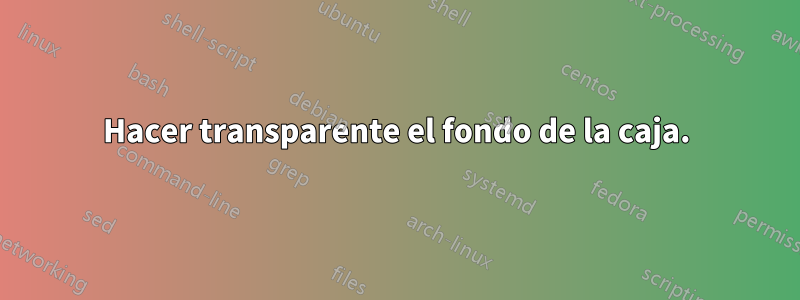
Como en mi documento tengo que escribir muchas matemáticas en cuadros de colores, me gustaría evitar escribir $ dentro de cada cuadro. ¿Hay alguna manera de definir newtcboxen modo matemático?
Lo intenté \newtcbox{\mywbox}[1]{<options>}{$\displaystyle #1$}pero no funciona.
Este es mi código de látex:
\usepackage{tcolorbox}
\newtcbox{\mywbox}{on line,colback=white,colframe=black,size=fbox,arc=3pt,boxrule=0.8pt}
\begin{document}
\obeylines
This \mywbox{$3x$} is in line math.
This $$y=\mywbox{$-5x$}-5+6$$ is not in line math.
\end{document}
Leí sobre \tcboxmathy \tcbhighmathen el manual oficial de tcolorbox, pero no entiendo cómo definirlos simplemente como newtcbox y si son lo que necesito.
Respuesta1
yo diría
\newtcbox{\mywboxtext}{on line,colback=white,colframe=black,size=fbox,arc=3pt,boxrule=0.8pt}
\newcommand{\mywboxmath}[1]{\mywboxtext{$#1$}}
Tu ejemplo puede convertirse
\documentclass{article}
\usepackage{tcolorbox}
\newtcbox{\mywboxtext}{on line,colback=white,colframe=black,size=fbox,arc=3pt,boxrule=0.8pt}
\newcommand{\mywboxmath}[1]{\mywboxtext{$#1$}}
\begin{document}
This \mywboxmath{3x} is in line math and this
\[
y=\mywboxmath{-5x}-5+6
\]
is display math.
\end{document}
Cambia los nombres a tu gusto.
Evitar $$en LaTeX(y por supuesto también \obeylines).
Si necesita que los cuadros se comporten en subíndices o superíndices, cambie el código a
\documentclass{article}
\usepackage{tcolorbox}
\newtcbox{\mywboxtext}{on line,colback=white,colframe=black,size=fbox,arc=3pt,boxrule=0.8pt}
\makeatletter
\newcommand{\mywboxmath}[1]{\mathpalette\mywboxmath@do{#1}}
\newcommand{\mywboxmath@do}[2]{\mywboxtext{$\m@th#1#2$}}
\makeatother
\begin{document}
This $\mywboxmath{3x}$ is in line math and this
\[
y_{\mywboxmath{0}}=\mywboxmath{-5x}-5+6
\]
is display math.
\end{document}
Tenga en cuenta que en este caso necesita que \mywboxmathesté en modo matemático.
Respuesta2
Puedes hacer esto usando \tcboxmathdesde la theoremsbiblioteca de tcolorbox:
\documentclass{article}
\usepackage{tcolorbox}
\tcbuselibrary{theorems}
\newcommand*{\mywbox}{%
\tcboxmath[colback=white, colframe=black, size=fbox, arc=3pt, boxrule=0.8pt]%
}
\begin{document}
This \mywbox{3x} is in line math.
This
\[ y = \mywbox{-5x} - 5 + 6 \]
is not in line math.
\end{document}
Es posible que también desees abstraer un poco las cosas usando un estilo, para poder aplicarlo a otros cuadros si surge la necesidad:
\documentclass{article}
\usepackage{tcolorbox}
\tcbuselibrary{theorems}
\tcbset{my math box/.style={
colback=white, colframe=black, size=fbox, arc=3pt, boxrule=0.8pt}
}
\newcommand*{\mywbox}{\tcboxmath[my math box]}
\begin{document}
This \mywbox{3x} is in line math.
This
\[ y = \mywbox{-5x} - 5 + 6 \]
is not in line math.
\end{document}
Hacer transparente el fondo de la caja.
Esto se puede hacer usando /tcb/opacitybackuna piel usando unrompecabezasmotor de bastidor, como standard jigsawo enhanced jigsaw.
\documentclass[fleqn]{article}
\usepackage{tcolorbox}
\tcbuselibrary{theorems}
\tcbset{
my math box/.style={
standard jigsaw, % useful for 'opacityback' and 'opacityframe'
colback=green!20, colframe=black, size=fbox, arc=3pt, boxrule=0.8pt,
opacityback=0.6,
}
}
\newcommand*{\mywbox}{\tcboxmath[my math box]}
\begin{document}
This \makebox[0pt]{%
\raisebox{-0.5\height}[0pt][0pt]{\hspace{1cm}\includegraphics{example-image-duck}}%
}%
\mywbox{3x} is in line math.
This
\[ y = \mywbox{-5x} - 5 + 6 \]
is not in line math.
\end{document}






